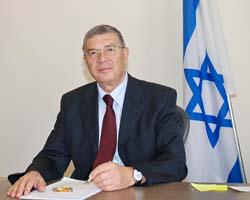27 April 2003

Chairman of the Yad Vashem Directorate Avner Shalev
In its 50th year, and upon receiving the prestigious Israel Prize for Lifetime Achievement – A Unique Contribution to Society and to the State, Yad Vashem is updating its approach to Holocaust commemoration while at the same time modernizing its physical landscape. The impetus for these changes stem from an increasing interest in the Holocaust worldwide and the urgent need to address Holocaust remembrance and commemoration for the future generation – a generation without survivors.
Educational activities as a top priority
In marking 50 years since its founding, Yad Vashem has decided to significantly expand its educational activities. In order to remain the central source for Holocaust remembrance and education in the next century and ensure Holocaust remembrance for future generations, Yad Vashem is placing primary emphasis on Holocaust studies for educators, students, soldiers, and youth in Israel and abroad, in the framework of the International School for Holocaust Studies that began operating in recent years at Yad Vashem. One of its goals is to ensure that every student in Israel participate in a full day seminar at the International School for Holocaust Studies at Yad Vashem. An additional goal is to train not only educators who work in the field of Holocaust history, but also in the fields of art, literature, film, etc.
Increased off-campus initiatives
An additional change in Yad Vashem’s approach will be a significant expansion of educational activities beyond its walls, extending into Israel and abroad. Educational initiatives outside Yad Vashem, which are currently 10% of its activities, will expand to 40%. Activities will include training sessions for teachers in Israel and abroad, mobile educational units that travel to schools and community centers, traveling exhibitions, Internet courses for educators and more. In addition, in the upcoming years, Yad Vashem plans to expand its cooperative activities with Holocaust institutions in Canada, the Ukraine, and Norway, among other places.
Opening of the new Museum Complex and new entrance
Yad Vashem is preparing itself for the millions of visitors that pass through its gates (about 2 million visitors came to Yad Vashem in 2000, the year of the outbreak of the Intifada) and for the new technological advancements that affect current museum approaches to Holocaust remembrance and the outlook of future visitors. Aside from a new entrance complex that will open in September 2003, that includes a new visitors’ center (Mevoah), which will provide modern, accessible services to visitors, Yad Vashem’s new museum complex, with the new Holocaust History Museum at its center, is nearing completion.
The opening of the Museum Complex in September 2004 will mark the completion of Yad Vashem’s multi-year development plan that will revolutionize the face of Yad Vashem’s character and approach to Holocaust remembrance and commemoration in the present and into the future. The new Holocaust History Museum will be three times larger than the current museum and will incorporate information and emphases that do not exist in the current museum (that was built over 30 years ago). The new museum will emphasize the Holocaust from a personal perspective through the exhibition of personal objects and the stories behind them. In addition, the museum will feature advanced technologies that will appeal to younger generations.
The architectural design of the museum will be a long and narrow path with galleries that open along the sides. The majority of the museum will be underground, with the exception of the entrance and the exit protruding from the mountain and skylights in the ceiling that will shine natural light into the museum. In addition to the Holocaust History Museum, the new Museum Complex will also include the Museum of Holocaust Art, the Exhibitions Pavilion, the Learning Center and the Visual Center for testimonies and films.
Moshe Safdie – of Safdie Architects, Inc. – is the architect of the museum complex and the entrance complex. The designer of the Holocaust History Museum is Dorit Harel – of Harel Designers, Inc. The chief curator of the museum is Avner Shalev, Chairman of the Yad Vashem Directorate, together with a team from the Yad Vashem Museums Division headed by Yehudit Inbar.
Establishment of the Eternal Endowment Fund for the Future of Yad Vashem
In order to ensure the future of Holocaust remembrance as an essential element of the Jewish and human experience, and to ensure Yad Vashem’s ability to work towards this goal, the Endowment Fund for the Future of Yad Vashem will be established. The initiation of the fund will take place during the opening events of the Jubilee year in September 2003 in the presence of the Minister of the Treasury and will be declared an international project for the Jewish people and other donors where each and every person will be asked to contribute to this crucial fund.
